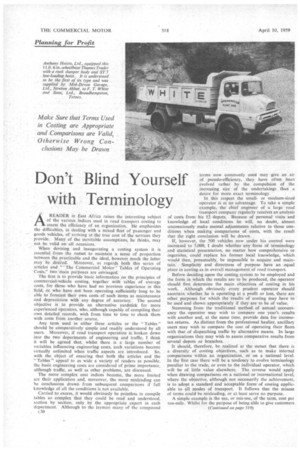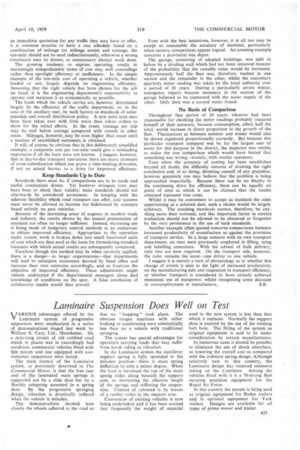Don't Blind Yourself with Terminology
Page 68

Page 71

If you've noticed an error in this article please click here to report it so we can fix it.
• A
' READER in East Africa raises the interesting subject of the various indices used in road transport costing to assess the efficiency of an organization. He emphasizes the difficulties, in dealing with a mixed fleet of passenger and goods vehicles, of arriving at the true cost of the services they provide. Many of the inevitable assumptions, he thinks, may not be valid on all occasions.
When devising and inaugurating a costing system it is essential from the outset to maintain a sense of proportion between the practicable and the ideal, however much the latter may be desired. Moreover, as regards both this series of articles and — The Commercial Motor' Tables of Operating Costs," two main purposes are envisaged.
The first is to provide basic information on the principles of commercial-vehicle costing, together with tables of average costs, for those who have had no previous experience in this field, or. who have not been operating sufficiently long to be able to forecast their own costs of such items as maintenance and depreciation with any degree of accuracy. The second objective is to provide an alternative yardstick for more experienced operators, who, although capable of compiling their own detailed records, wish from time to time to check them with costs from another source.
Any term used in either these articles or the " Tables" should be comparatively simple and readily understood by all users. Moreover, if road transport operation is. broken down into the two departments of engineering and traffic, I think it will be agreed that, whilst there is a large number of variables influencing engineering costs, such variations become virtually unlimited when traffic aspects are introduced. So, with the Object of ensuring that both the articles and the " Tables " appeal to as wide a variety of readers as possible, the basic engineering costs are considered of prime importance, although traffic, as well as other problems, are discussed.
The more complex cost indices become, the more limited are their application and, moreover, the more misleading can be conclusions drawn from subsequent comparisons if full knowledge of all the conditions is not available.
Carried to excess, it would obviously be pointless to compile tables so complex that they could be read and understood. section by section, only by the appropriate expert in each department. Although to the layman many of the compound . c.30 terms now commonly used may give an air of pseudo-efficiency, they have often been evolved rather by the compulsion of the increasing size of the undertakings than a desire for more exact terminology.
In this respect the smallor medium-sized operator is at an advantage. To take a simple example, the chief engineer of a large road transport company regularly receives an analysis of costs from his 12 depots. Because of personal visits and knowledge of local conditions he will, no doubt, almost unconsciously make mental adjustments relative to those conditions when making comparisons of costs, with the result that the right conclusion will be drawn.
If, however, the 500 vehicles now under his control were increased to 5,000, I doubt whether any form of terminology and statistical presentation, no matter how comprehensive or ingeniOus, could replace his former local knowledge, which would then, presumably, be impossible to acquire and maintain: Simplicity and directness of purpose have an equal place in costing as in overall management of road transport.
Before deciding upon the costing system to be employed and the form in which the results are to be produced, the operator should first determine the main objectives of costing in his work. Although obviously every prudent operator should ascertain whether he is operating at a profit or loss, there are other purposes for which the results of costing may have to be used and shown appropriately if they are to be of value.
Stemming from the traditional method, of annual accountancy the ,operator may wish to compare one year's results with another and, at the same time, provide data for incometax returns. As distinct from the professional haulier, ancillary users may wish to compare the cost of operating their fleets with that of dispatching traffic by alternative means. In large organizations they may wish to assess comparative results from several depots or branches.
It should, therefore, be realized at the outset that there is a diversity of costing objectives, such as to make internal comparisons within an organization, or on a national level. In the first case there will be a tendency to evolve terminology peculiar to the trade, or even to the individual operator, which will be of little value elsewhere. The reverse would apply when drawing comparisons on a national or international level, where the objective, although not necessarily the achievement, is to adopt a standard and acceptable form-of costing applicable to all modes of transport. It follows that the misuse of terms could be misleading, or at least serve no purpose.
A simple example is the use, or mis-use, of the term, cost per ton-mile. Whilst for the purpose of being able to give customers (Continued on page 319)
an immediate quotation for any traffic they may have to offer, it is common practice to have a rate schedule based on a combination of mileage (or mileage zones) and tonnage, the ton-mile should not be used indiscriminately, otherwise a wrong conclusion may be drawn, or unnecessary clerical work done.
The growing tendency to express operating results in increasingly comprehensive terms of cost may well camouflage rather than spotlight efficiency or inefficiency. In the simple example of the ton-mile cost of operating a vehicle, whether loaded or not, largely depends on engineering efficiency. Assuming that the right vehicle has been chosen for the job on hand, it is the engineering department's responsibility to operate and maintain it as economically as possible.
The loads which the vehicle carries are, however, determined largely by the efficiency of the traffic department, or, in the case of the ancillary user, by such factors as standards of salesmanship and overall distribution policy. A new sales area may have been taken over with little more than token orders to show for the initial efforts. In the event, tonnage per trip may be well below average compared with rounds in other areas. Mileages, however, may be even higher than usual until a nucleus of established customers is obtained.
It will, of course, be obvious that in this deliberately simplified example, a composite cost per ton-mile could give a misleading impression if all the facts were not known. I suggest, however, that in day-to-day transport operations there are many elements of cross-subsidization which can prove a time-wasting diversion, if not an actual barrier to a drive for improved efficiency.
Keep Standards Up to Date
Standards there must be, if comparisons are to be made and useful conclusions drawn. Yet however stringent tests may have been to check their validity, basic standards should not afterwards be considered permanent. In keeping with the inherent flexibility which road transport can offer, cost systems must never be allowed to -become too hidebound by concepts based entirely on past statistics. "
Because of the increasing sense of urgency in modern trade and industry, the results shown by the annual presentation of accounts are often no longer sufficient. Instead, increasing use is being made of budgetary control methods in an endeavour to obtain improved. efficiency. Appropriate to the operation under review, work is broken down into small functional units of cost which are then used as the basis for formulating standard forecasts with which actual results are subsequently compared.
Excellent though this method may be when correctly applied, there is a danger—in larger organizations—that departments will tend to anticipate economies decreed by head office and increase their own estimates accordingly, and so frustrate the objective of improved efficiency. These adjustments might remain undetected if the departmental managers alone had knowledge of conditions on the spot. A false conclusion of satisfactory results would then prevail. Even with the best intentions, however, it is all too easy to accept as reasonable the accuracy of statistics, particularly when cursory comparisons appear logical. An amusing example concerns a provincial bus depot.
The garage, consisting of adapted buildings, was split in halves by a dividing wall which had not been removed because of the probability that the rateable value would be increased. Approximately half the fleet was, therefore, washed in one section and the remainder in the other, whilst the customary quarterly meter reading was taken by the local authority over
a period of 20 years. During a particularly severe winter, emergency repairs became necessary in the section of the garage believed to be ecinnected with the water supply of the other. Only then was a second meter found.
No Basis of Comparison
Throughout that period of 20 years, whoever had been responsible for checking the meter readings probably reasured himself of their accuracy, because consumption, albeit half the total, would increase in direct proportion to the growth of the fleet. Fluctuations as between summer and winter would also be shown registered proportionally correctly. But because this particular transport company was by far the largest user of water for this purpose in the district, the inspector was unable to make the one comparison which would have hinted that something was wrong—namely, with similar operators.
Even when the accuracy of costing has been established beyond all doubt, the difficulty remains of drawing the right conclusion and, in so doing, divesting oneself of any prejudice, however genuinely one may believe that the problem is being approached impartially_ Because there can be no finality in the continuing drive for efficiency, there can be equally no point of time at which it can be claimed that the results obtained represent true costs.
Whilst it may be convenient to accept as standard the costs appertaining at a selected date, such a choice would be largely arbitrary. The resulting standards cannot, therefore, be anything more than notional, and this important factor in correct evaluation should not be allowed to be obscured or forgotten by the very persistence in the use of such standards.
Another example often quoted concerns comparisons between increased productivity of manufacture as against the provision of transport service. In a large concern with its own transport department, six then were previously employed in filling, tying and labelling containers. With the advent of bulk delivery, only two are now required. On the transport side, however, the ratio remains the same—one driver to one vehicle.
I suggest it is merely a turn of phraseology as to whether this change of events is seen in the light of increased productivity on the manufacturing side and stagnation in transport efficiency, or whether transport is considered to have already achieved maximum use of manpower, whilst recognising some decrease in overemployment in manufactureS.B.












































































































